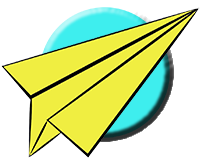Fold a Condor Paper Airplane
Fold a Condor Paper Airplane
Instructions
This interesting looking square craft works best with light to medium weight paper. Start with a letter size sheet.
1. Fold the paper exactly in half along its long edge. Unfold after the crease has been made.
2. Rotate the paper around so the center line crease is vertical. Fold the upper left corner down so the upper left point hits the center line crease. When folded correctly, the left half of the top edge should line up with the center line crease. Unfold after the crease has been made.
3. Fold the upper right corner down so the upper right point hits the center line crease. Unfold after the crease has been made.
4. Fold the upper left corner down so the upper left point hits the diagonal crease on the left side. When folded correctly, the left half of the top edge should line up with the diagonal crease.
5. Fold the upper right corner down so the upper right point hits the diagonal crease on the right side. When folded correctly, the right half of the top edge should line up with the diagonal crease.
6. Fold the top point down so the point hits the right edge of the paper. When folded correctly, the upper right diagonal edge should line up with the right edge of the paper.
7. Unfold the flap just created. Fold the top point down so the point hits the left edge of the paper. When folded correctly, the upper left diagonal edge should be lined up with the left edge of the paper.
8. Unfold the flap just created.
9. Make a crease to fold the nose tip down. The left and right points of the crease should be at the outside flaps are folded down. When folded correctly, the point on the tip of the nose should hit the center line crease. Unfold the crease you just made.
10. Flip the paper over so the flaps just created are underneath. Keep the flaps and creases at the top.
11. Make a crease to fold the supper left and right points down. The crease should go through the center point created by the diagonal creases. When folded correctly, the upper left and right points should hit the left and right edges of the paper.
12. Unfold the flap just made and flip the paper over, keeping the flaps and creases at the top.
13. Pop the horizontal creases up and fold in and down towards the center line crease. Press the lower triangles down and flat against the plane’s main body. Bring the upper left and right corner points up and in towards the middle.
14. Rotate the paper around so the nose points to the left.
15. Fold the leading edge of the plane back on top of itself so that it touches the vertical standing part of the paper.
16. Repeat above for the other side of the plane
17. Flatten out the currently vertical standing part of the paper to that so that the page is completely flat again with the point of the planes nose at the top.
18. Flip the plane over.
19. Fold the pointed nose of the plane back on itself as shown. The distance from the new fold to the point should be about 2 inches (5 cm).
20. Fold the plane in half along the center line.
21. Fold the first wing.
22. Flip the plane over.
23. Fold the second wing. Be sure it is even with thr first wing to ensure good balance.
24. Open up the wing flaps and adjust the wing angles so they are even. Set the dihedral angle slightly up. The addition of a piece of tape top and on the bottom of the wings will reduce drag for faster flights.
THE THROW: When folded properly this craft requires very little trimming. Launch with a medium to hard level throw. It can also be launched rather hard straight up.
